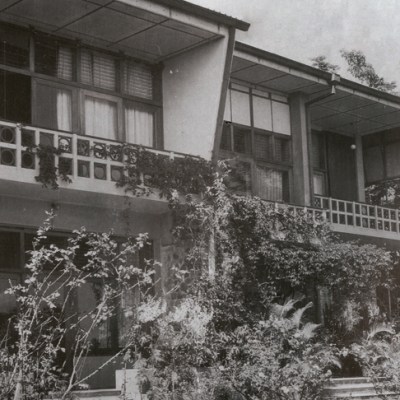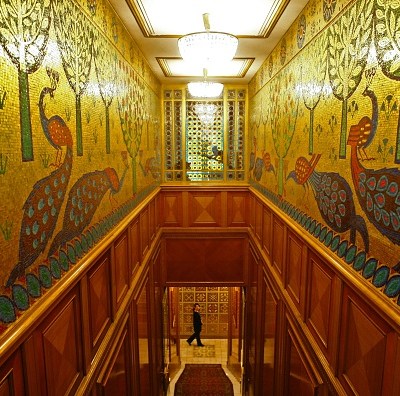Forget about the Champions League Final: last month, Kyiv Art Week was the only game in town. On opening night, collectors jostled with hip young things while a crowd of hopefuls tried to blag their way in. There was no free booze: they must have been there for the art.
This hunger for contemporary art is typical of the creative renaissance Kyiv (Kiev) has been undergoing since the revolution of 2014. Art flourishes in interesting times, they say, and a combination of political upheaval, cheap rents and plentiful space has created the conditions for the kind of vibrant underground music and art scene that took hold in Berlin in the 1990s. But while festivals like Brave! Factory have put Kyiv’s electronic music scene on the European map, its contemporary art world remains internationally isolated and badly in need of development on an institutional level. Kyiv Art Week aims to change that by promoting local artists and fostering much-needed international connections. Its third edition this year featured 33 local and foreign galleries alongside a lively satellite programme of exhibitions, events and lectures.
The satellite programme deserves credit for its contribution to one of Ukraine’s thorniest public debates in recent years: the question of what to do with the country’s Soviet heritage. A decommunisation law in 2015 forbade the hammer and sickle and saw thousands of Lenin statues topple across the country. But the fate of other Soviet monuments is less clear. Destroy, alter, or preserve for posterity? An exhibition of photographs by Yevgen Nikiforov at the Palace of Children and Youth, the former Soviet pioneers’ headquarters, examined with a keen sense of irony the ways in which monuments have been vandalised, concealed or absurdly decorated. The budget option: just paint them blue and yellow.
The crematorium in the Park of Memory, Kyiv, designed by Abraham Miletsky, photographed in May 2018. Photo: the author

Meanwhile, lectures and debates spoke up for the city’s Soviet architectural heritage. In buildings like Abraham Miletsky’s crematorium or his Hotel Salyut, Kyiv boasts some of the finest, most exuberant examples of late Soviet modernism, many of which are now under threat. Florian Yuriev’s Ministry of Information, which centres on an extraordinary flying saucer-shaped concert hall, is at risk of development by a neighbouring shopping centre – because current legislation excludes buildings constructed between 1955–91 from protection as cultural heritage. As long as military conflict continues in the east of the country, such simplistic, nationalist attitudes to the Soviet era are likely find their way into law.
The Ministry of Information in Kyiv, designed by Florian Yuriev and completed in 1971; photographed in May 2018. Photo: the author

It was cheering therefore to see the curators of the Kyiv Art Week take a more nuanced approach to the past. Mostly in their thirties, they remember the Soviet Union and have no desire to return to it. But you don’t have to be a card-carrying communist to recognise the value of these buildings. Good things can be built in bad regimes. Sometimes, even, in spite of them.
The same went for the Museum of Russian Painting, where a temporary exhibition of Ukrainian and Georgian Thaw-era artists was mounted on the floor below the Vrubels, Repins and Shishkins. Made for private consumption and described by the curator as an ‘intellectual protest against the Soviet world order’, these works serve as a reminder that not all art produced during the Soviet Union was automatically bad or ideologically tainted. In Ukraine right now, this feels like something worth saying.
Two of these artists, Ada Rybachuk and Volodymyr Melnichenko, spent seven years working together on the Wall of Remembrance in Kyiv’s Baikove Cemetery: a 214 metre-long narrative relief designed to line the funerary route to Miletsky’s crematorium, built in 1975. In spring 1982, two weeks after they had finished their work, Rybachuk and Melnichenko were accused of ‘formalism’ by the Politburo and the entire wall was entombed in concrete.
Ada Rybachuk and Volodymyr Melnichenko’s Wall of Remembrance, photographed in May 2018. Photo: the author

Last month, a small section of the concrete was ceremonially chipped away to mark the start of Kyiv Art Week. It is hoped that a crowdfunding campaign will result in the removal of the rest. The octogenarian Melnichenko, having campaigned for half a lifetime for this moment, was there to see his work revealed. The exposed relief featured an expressionistic head tilted skywards, as though about to gulp for air. When I visited a few days later, someone had left flowers by it.
Kyiv Art Week was at various venues from 18–27 May.


